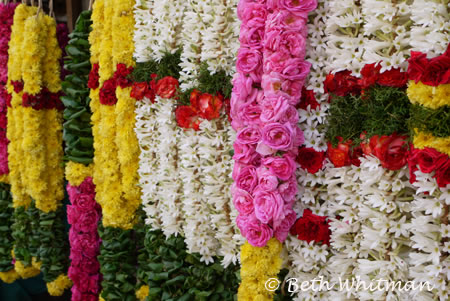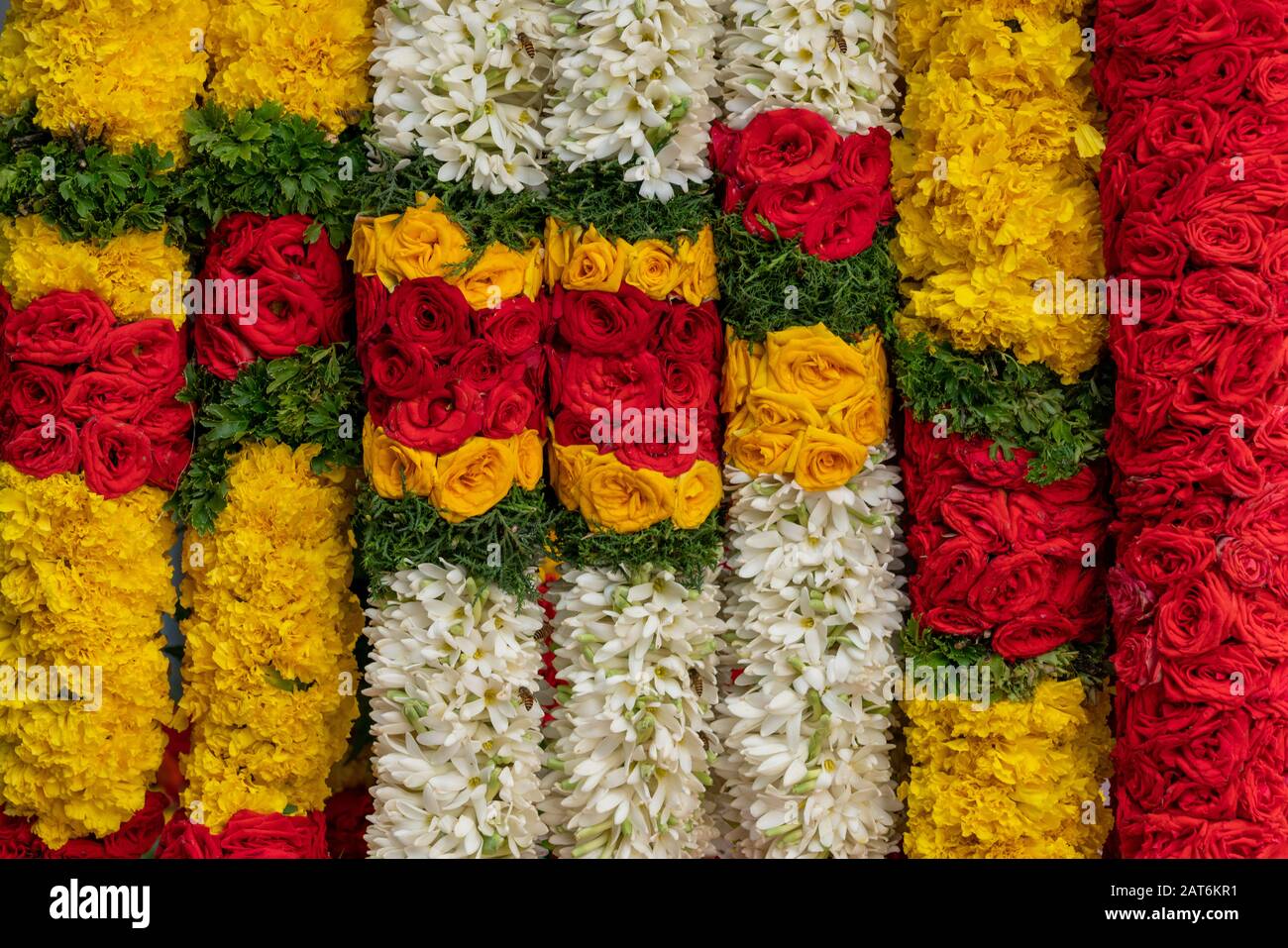ॐ श्री गणाधिपतये नमः
Source of all Images in this Blog-post : Google Images : ‘Google Image Search’ will reveal the multiple sources of every single image shared in this Blog. For more details, kindly see ‘Disclaimer‘

In India, flower garlands have an important and traditional role in every social and religious festival. Hindu deities are decorated with garlands made from different fragrant flowers (often jasmine, rose, tube rose and marigold) and fragrant leaves.
Both fragrant and even non-fragrant flowers and religiously-significant leaves like Marukozhunthu, Thulasi, Vilva, Durva grass etc are used to make garlands to worship Hindu deities. Some of these flowers are as follows: jasmine, Champaka, lotus, lilies, Ashoka, nerium/oleander, chrysanthemum, roses, hibiscus, pinwheel flowers, Manoranjini etc.

Nila Maalai: Adorning Doorways in Tamil Nadu House-Warming Celebrations
In the vibrant cultural landscape of Tamil Nadu, the decoration of the main door frame during house-warming parties is a practice steeped in tradition, known as Nila Maalai. This door frame garland is not just a decorative element but a symbol of auspiciousness and welcome.
Besides the usual flowers, an array of leaves and grasses, including Arugampul, Maruvakam, Davanam, Maachi, Panneer leaves, and Lavancha, are intricately woven into these garlands, adding a unique touch to the adornment. In some instances, the creativity extends to the inclusion of fruits, vegetables, and even currency notes in the garlands, symbolizing prosperity and thanksgiving.
This practice reflects the rich tapestry of customs in Tamil Nadu, where even the simplest of decorations is infused with deep meaning and cultural significance.

In Hindu weddings, the bride and groom wear a beautiful, colourful wedding garland. On other occasions, a flower garland is used to show respect and devotion to a human individual or a statue or picture of God.

In Tamil Nadu, marigold flower garlands are used only for dead bodies and last rites.

The Gajra: A Fragrant Tradition in North Indian Festive Hairstyles
A Gajra, traditionally worn by women in North India, is a symbol of cultural elegance and festivity. This flower garland, typically crafted from the sweet-scented jasmine, is a cherished accessory in traditional celebrations.
Women artfully weave these Gajras into their hair, adorning them around buns or intertwining them in braids. This floral ornament becomes particularly prominent when women dress in traditional sarees, adding a touch of natural beauty and fragrance to their ensemble.
The Gajra is not just a decorative item; it’s a representation of heritage and femininity, deeply rooted in the cultural fabric of North India. Its presence during festivals and special occasions is a testament to the enduring charm and significance of this simple yet elegant floral tradition.

The Ancient Tradition of Nandavanams in Tamil Nadu’s Hindu Temples
In the rich tapestry of Hindu temples across ancient Tamil Nadu, there existed a profound tradition where kings appointed dedicated individuals to craft garlands daily for the deities. Central to this practice were the Nandavanams, or heavenly flower gardens, nestled within each temple’s precincts.
These gardens were meticulously cultivated to grow an array of floral plants and special tree leaves, specifically for the creation of sacred garlands. This tradition is vividly alive in grand Shiva temples like the Thillai Nataraja Temple in Chidambaram, Thyagaraja Temple in Tiruvarur, and Arunachaleswara Temple in Thiruvannamalai. These temples continue to uphold the legacy of their Nandavanams, ensuring a steady and sacred supply of flowers and leaves for the daily rituals.
This enduring practice not only reflects the religious significance of nature in Hindu worship but also highlights the historical importance placed on the harmonious coexistence of natural beauty and spiritual devotion in Tamil culture.

Preserving the Nandavanams: Insights from the Stone Inscriptions at Brihadeeshwara Temple
The stone inscriptions of Raja Raja Chola I at the Brihadeeshwara Temple in Thanjavur reveal the remarkable efforts of royal patronage in conserving the Nandavanams, the sacred gardens surrounding this architectural wonder. These Nandavanams, more than just botanical landscapes, were integral to the temple’s ecosystem, enhancing its spiritual ambiance and natural beauty.
The inscriptions detail how the Chola dynasty dedicated resources and meticulous care to maintain these gardens, underscoring their importance in religious practices and daily temple life. They were not merely aesthetic additions but played a vital role in religious rituals and provided medicinal plants, flowers for worship, and a serene environment for meditation and gatherings.
The preservation of these Nandavanams by Raja Raja Chola I highlights the deep connection between nature and spirituality in the Hindu tradition and the foresight of ancient rulers in environmental stewardship. This commitment to the holistic care of the temple complex, including its natural elements, exemplifies a unique blend of devotion, culture, and ecological awareness in ancient Indian civilization.

In Srirangam in Tamilnadu, Sri Ranganathar temple only uses garlands made by temple Sattharars (people whose only job is to make garlands for the temple. Sattharars never marry, surrendering their whole life to the service of the Lord). No other flower garlands are used to adorn Lord Ranganatha in Srirangam temple.
Temple Sattarars have traditional rules for everything – from plucking flowers to making garlands. Some of them are as follows:
The flowers should be plucked in the early morning.
The flowers should not be smelled by anyone.
They should be plucked only after having bath.
The flowers which fall down on earth or dirt should not be used. Naamajapam or the chanting of holy names should be done while plucking flowers.
While making garlands they keep flowers and other materials on a table because the garland for God should not touch the feet. It is always kept above hip level.

Depending upon the patterns and materials used, the south Indian garlands are of different types. Some of them are as follows:
Thodutha Maalai – which means garlands made using banana tree fibers. Most of the garlands used for Hindu marriages and temple worship in southern India are made using this method.
Kortha Maalai – made using needle & thread. Jasmine, Mullai, and lotus garlands are made using this method.
The Maala for Gods has 2 free lower ends with Kunjam (bunch of flowers). Each Hindu deity has a unique garland :
Goddess Lalitha wears hibiscus garland,
Lord Vishnu wears Thulasi leaves garland,
Lord Shiva wears Bilva leaves garland,
Lord Subrahmanya wears jasmine garland,
Mahalakshmi wears red lotus,
Saraswathi Devi wears white lotus garland,
Durga Devi wears nerium oleander garland and
Vinayaka wears garland made of Durva Grass.
Conclusion
In conclusion, the art of Poo Maalai in Tamil Nadu is more than just a craft; it is a vibrant expression of culture, devotion, and tradition that illuminates Indian weddings and temple worship. These meticulously crafted garlands are not just adornments but symbolize the beauty, fragrance, and sanctity of the occasions they grace. Each thread intertwined in these floral creations carries centuries of heritage, showcasing the skill and dedication of the artisans who keep this tradition alive.
As we admire these stunning garlands, we are reminded of the rich tapestry of Indian customs and the deep-rooted connection between nature and spirituality in Tamil culture. The Poo Maalai, in all its colorful and fragrant glory, stands as a testament to the enduring beauty and tradition of Tamil Nadu, weaving together the past and the present in its delicate petals.
